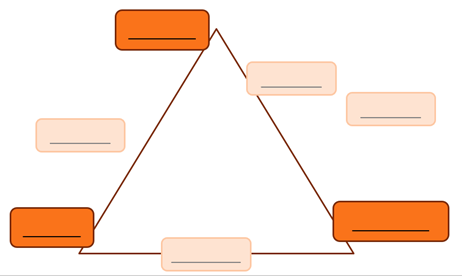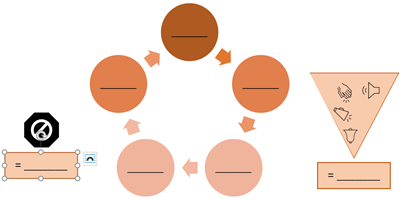The definition of technical communication
Technical communication encompasses a set of activities that people do
to discover, shape, and transmit information in order to
analyze a problem
find and evaluate evidence
draw conclusions
What is the Classical Greek definition of rhetoric?
What is the modern definition of rhetoric?
Classical Greek Rhetoric = the available means of persuasion
Modern Rhetoric = the means by which a messenger encodes a specific purpose into a message for a specific audience as effectively as possible
Name 3 of 5 suggestions for presenting yourself as a professional in your correspondence:
Use the appropriate level of formality.
Communicate correctly.
Project the “you attitude.”
Avoid correspondence clichés.
Communicate honestly
evaluating other peoples and cultures according to the standards of one's own culture
What do directives do?
Directives explain a policy or a procedure you want readers (usually employees) to follow.
Name 3 differences between academic and technical writing
TW uses reports, correspondence, and virtual environments; academic writing uses essays, papers, and stories
Academic: Elaborate, transitional expressions, subjectivity; TW: Plain language, objectivity, to-the-point but
Academic: Complex, embellished, wordy, synonyms, passive voice; TW: Straightforward, simple, active voice
Academic: Long, 6+ lines of text; less formatting & few visuals; TW: Short, less than 6 lines of text; lists, headings, design, visuals
Academic: more theoretical; TW: more practical
Name 3 of the characteristics an author or speaker should learn about their audience.
Educational background
Cultural characteristics
Attitudes
Professional experience
Personal characteristics
Expectations
Job responsibility
Reading, speaking, listening preferences
Context of message use
What is an inquiry letter and what should organizations include in their responses?
Inquiry: write to acquire information about a product, service, etc.
Response: answer the questions in an inquiry letter, or explain why you cannot answer the questions and what you will do about it
Name 3 effects successful intercultural communication produces.
Increasing diversity of workforce
Creative problem-solving strategies
Technology speeds up our global identities
Facilitates healthcare and social programs
Global peacemaking initiatives
Self- and other-awareness
What do field reports do?
Field reports describe inspections, maintenance, and site studies.
--explain problems, methods, results, and conclusions
--deemphasize methods and can include recommendations
Name 3 skills and qualities shared by successful workplace communicators
Perform research
Analyze information
Speak and write clearly
What are the typical purposes for technical communication?
to inform
to instruct
to analyze--a problem, evidence, and conclusions
What is a claim letter?
What should be included in an adjustment letter or a denial/refusal letter?
Claim: write a polite, reasonable complaint and explicitly request what you want the audience to do to compensate you
Acceptance: express regret about the situation and explain what you will do to adjust the situation to the audience’s needs
Denial: write in order to maintain goodwill and to explain why you are denying the claim; educate the audience
Name 3 cultural variables that are "on the surface."
Political
Economic
Social
Religious
Educational
Technological
Linguistic
What is the difference between white papers and briefings?
What do they both include?
White Papers & Briefings are informative reports used to inform management or clients about an important issue.
White papers generally written and briefings typically oral.
Include summary of facts, discussion of importance of facts, forecast about the importance of the facts in the future.
Be concise.
Successful technical communication is (name 3 of six traits)
reader focused
problem-solving
appropriately designed
reflective or organizations goals and culture
includes words and images
produced collaboratively
Fill in the diagram for the rhetorical triangle.

Describe how each of the following elements of a letter are used.
Heading
Inside address
Salutation
Complimentary close
Signature
Heading: the author's/company's name and address +
Inside address: the recipient's name and address
Salutation: the greeting; "Dear..."
Complimentary close: the sign-off; "Sincerely..."
Name 3 cultural variables that are "beneath the surface."
Focus on individuals or groups
Distance between work and private lives
Distance between ranks
Need to details to be spelled out
Attitudes toward uncertainty
What are the two types of analytical reports we covered, and what does each one do?
Completion Reports are analytical reports written for management or clients. They assess the outcomes of a project or initiative.
Feasibility Reports are analytical reports that are written to determine whether developing a product or following a course of action is possible or sensible.
Effective technical communication is (name 3 qualities)
•honest
•clear
•accurate
comprehensive
accessible
concise
professional in appearance
correct
Fill in the diagram for the communication loop.

Describe what each of the following is used for.
attention line
subject line
enclosure line
copy line
attention line: draws attention from a department head or job title
subject line: provides numerical IDs or record numbers, or phrasing that tell what the correspondence is about
enclosure line: lists any additional documents or material sent with the correspondence
copy line: lets the recipient(s) know who the correspondence is copied to
Name 4 guidelines for successful intercultural communication.
Limit your vocabulary.
Keep sentences short.
Define abbreviations and acronyms in a glossary.
Avoid jargon unless you know your readers are familiar with it.
Avoid idioms and slang.
Use the active voice whenever possible.
Be careful with graphics.
Be sure someone from the target culture reviews your document.
What is the difference between a progress report and a status report?
What are their similarities?
Progress Report describes an ongoing project.
Can be an intermediate communication between a proposal and a completion report or a recommendation report.
Be honest about author qualifications, project goal, timing, and budget.
Tone should be objective, neither defensive nor casual.
Status Reports describe the entire range of operations of a department or division. Sometimes called an activity report.
Concerning Both
Typically uses the time pattern or the task pattern.
In the conclusion, evaluate how the project or department is proceeding.
If appropriate, use appendixes for supporting materials, such as computations, printouts, schematics, diagrams, tables, or a revised task schedule.